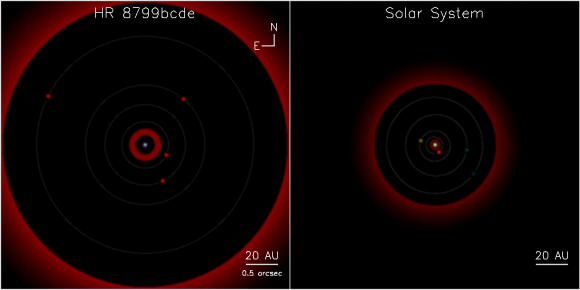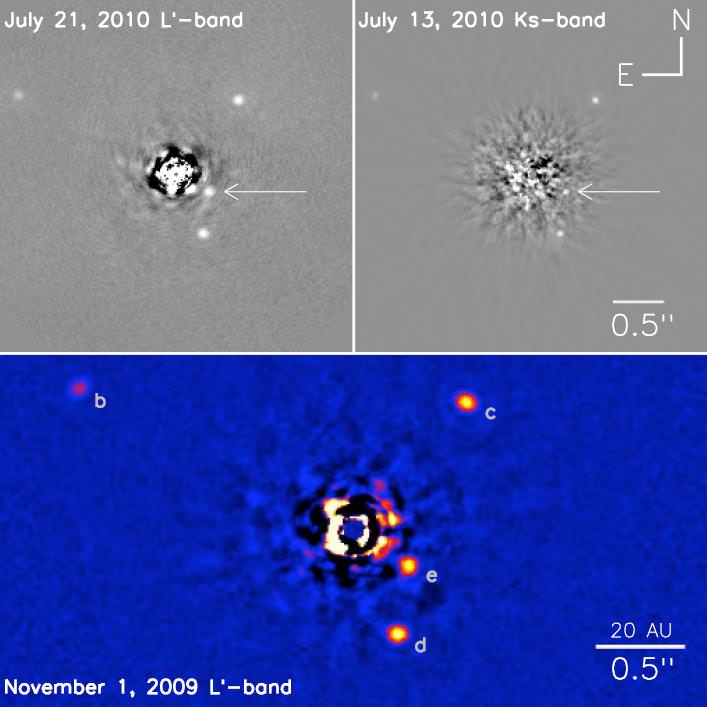[/caption]
Among one of the first exoplanet systems imaged was HR 8799. In 2008, a team led by Christian Marois at the Herzberg Institute of Astrophysics in Canada, took a picture of the system directly imaging three giant planets. The team revisited the system in 2009 – 2010 with the Keck II telescope and discovered a fourth planet in the system.
The new planet, designated HR 8799e, orbits at a distance of 14.5 AU, making it the innermost planet in the system. The other planets all orbit at distances of >25 AU. The images were taken in the near infrared where they are most noticeable because the system is relatively young (<100 Myr) and the planets are still radiating large amounts of heat from their formation.
The youth of these planets is part of what makes them an interesting target for astronomers. There exists a controversy in the community of planetary astronomers on the formation method of large planets. One theory states that planets form from a single, monolithic collapse that creates the entire planet’s mass at one time. Another possibility is that the initial collapse forms small cores early on, but then there is substantial growth later, as the planetesimal sweeps up additional material.
The discovery of the new planet challenges both theories. Marois states, “none of [the theories] can explain the in situ formation of all four planets.” Thus, a combination of both methods may be in use in the system. Several belts of dust are also known in the system which may help astronomers determine what modes of formation were present.
In particular HR 8799e is challenging to an in situ formation because the gravitational perturbations from the parent star should disrupt the formation of large gas planets within 20-40 AU from a single formation. Instead, the new planet would likely have had to been a core collapse with subsequent accretion, or alternatively, moved to its present location via migration.

Studying systems such as this may help astronomers better understand the formation of our own solar system. The paper notes that the HR 8799 “does show interesting similarities with the Solar system with all
giant planets located past the system’s estimated snow line (~2.7 AU for the Solar system and ~6 AU for HR 8799)”. Additionally, both have debris disks beyond the outer orbits with similar temperatures.
Different methods of detecting planetary formation necessarily turn up different types of systems. Radial velocity studies detect massive, close-in planets whereas direct imaging most easily finds more distant planets. These two apparent populations represent different modes of planetary formation and for a full understanding, astronomers will need a continuous sampling that merges the two. Marois notes that we are still far from this goal as “[w]e just do not have enough exoplanets detected by direct imaging (~6 so far)” to make any conclusions besides constraints from the non-detections occurring thus far. To truly merge these two populations, astronomers will likely need to wait until more systems are discovered.
Previously, some work has been done to estimate the composition of the atmospheres of the three planets already discovered in the system. These systems have been suggested to have cloudy atmospheres for CH4 and CO. According to Marois, his team is, “planning more observations on e, but it will be hard. We might have to wait for new instruments, like the Gemini Planet Imager to do it properly.” This new instrument “will put a ‘thumb’ on the star (or what we call a coronagraph) to physically block the star light and allow ‘easy’ detection of nearby faint planets.”
While this discovery is a first, it will certainly be one of a long line of exoplanet images. Marois is obviously excited about the ability to directly image planets. I asked him what the single most important thing he wanted readers to get from this research. His response was simple, “That we now have the telescopes and instruments to SEE planets orbiting other stars – that’s really cool! The exoplanet field is still very young and we have so much to learn.”


It is cool!
Then again…
Classic SMBC.
I find the Patterns surrounding the star and planets even more fascinating.
Are we seeing the wake of the solar system ? Magnetic field lines?
Planet C and D for instance seem to have a spiral flow between them.
Here is a wild idea, in a young solar system plasma currents from the sun create gravity wells in the planetary disc, these hot wells coalesce into planets.
The sun gives birth to the planets?
@damian
No, it’s just artifacts from the imaging technique. The images aren’t photographs in the common sense, it’s better to think of it as visualised data. That is, the images don’t represent what a nearby human would see, but it does enable astronomers to detect the planets.
The method relies upon IR from young planets, and will not find older solar systems such as our own. This method could though be used to find a wide array of stellar systems, and to determine the “sample space” of solar system configurations.
LC
I posted this in “Astroid Sheila Sprouts a Tail” but, it relates to this thread so, I’ll re-post here. Sorry if I broke protocol.
I wonder if a sol’s outbursts in early “close-in” planetary formation could be influential in outward migration. I would assume a young forming star would be pretty active.